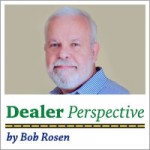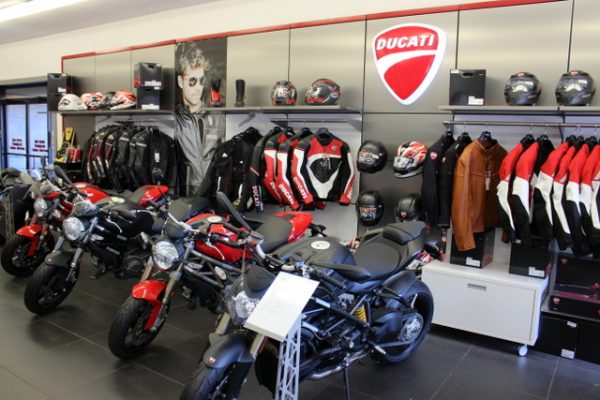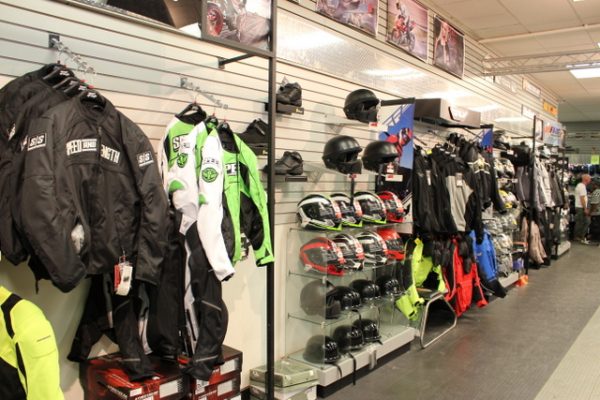 In previous columns, we’ve had a look at how the sales and service departments affect the financial health of motorcycle dealerships. They are two legs of the “three legged stool” of dealership success. The third critical business area for successful dealerships is
In previous columns, we’ve had a look at how the sales and service departments affect the financial health of motorcycle dealerships. They are two legs of the “three legged stool” of dealership success. The third critical business area for successful dealerships is
the revenue (and profits) generated from the sale of
repair parts, riders’ clothing, and motorcycle accessories. Collectively, this business is often called PG&A (parts, garments, and accessories).
All motorcycle manufacturers offer a broad range of non-motorcycle products. Most of us, however, would agree that Harley-Davidson and its dealers have done a terrific job of presenting riders with an almost unending variety of goodies and repair/modification parts to feed their need for creating a unique riding experience.
In 2013, Harley-Davidson reported more than a billion dollars of revenue for their PG&A products. That’s about 20% of the $5.2 billion total revenue for the Motor Company. And profits from the sale of PG&A are much higher on a percentage basis than the sale of bikes. The profit dollars generated from a billion dollars worth of PG&A is comparable to the profit created from the sale of nearly three billion dollars worth of motorcycles.
While the PG&A revenue and profit numbers for individual dealers are a lot less spectacular, they are still an important part of each dealer’s success. As you’ve seen from visiting various showrooms, the PG&A offerings can vary widely. The aforementioned H-D dealer presentation is like walking into a big motorcycle candy store – sometimes overpowering the actual display of bikes.
Then there are dealers who are obviously unwilling (or unable) to make the investment in a strong PG&A department. These dealers are missing an opportunity to generate substantial revenue and profits while increasing traffic flow into their stores. Gross profits from the sale of OEM parts, aftermarket accessories, and rider’s apparel can range from 30% to more than 50%.
At an average of 40%, the dealership gets to keep forty cents for every dollar of PG&A sold. Contrast that with 12% to 20% gross profit on the sale of new motorcycles (discounting bike prices can easily lower these numbers into single digits).
Cash flow is one of the biggest barriers to building a comprehensive PG&A department. Unlike motorcycles, dealers must pay for all parts, accessories, and apparel they add to their inventory. With the exception of a few creative short-term financing plans, the dealer must write a check to his supplier for all PG&A items brought into the store.
Motorcycles are generally financed via “floor plan” programs. The manufacturer isn’t paid until the dealer has sold the bike. So, all of the PG&A items sitting on the showroom floor and in the storage room represent an expenditure of cash well in advance of the actual sale of those products. Run low on cash and the dealer can’t buy any more. This where the concept of “inventory turns” becomes an important measure of dealership performance.
Most retail operations keep an eye on how frequently their inventory turns. Simply put, this is a measurement of how often the total inventory is sold in a given period, typically in one year. Some high-turnover industries, like the retail grocery business, measure their inventory turns in terms of days or weeks. Turning inventory at the correct rate means that there is a higher probability that sufficient cash flow will be created to sustain the business.
Low inventory turns mean that cash is sitting on the shelf, not being put to work. There are a few industry guidelines that provide motorcycle dealers with benchmarks to help them optimize inventory levels. For instance, “hard parts” inventory (motorcycle repair and maintenance items) should turn at a rate of around seven times per year. The sales of these parts are more predictable so order quantities and frequency can be better managed.
On the other hand, apparel and other “soft” goods typically turn at lower rate – ideally around three times per year. Less predictable demand and seasonality play into this side of the business.
Of course, managing the inventory is only one side of the PG&A equation. Savvy dealers put a large amount of effort into stimulating demand from the rider community. Without sales, the inventory on the shelf and in the showroom is truly dead.
Knowing your market is the first key ingredient to successful PG&A sales. At our BMW/Ducati dealership we sold a ton of $400+ full-face helmets. That same inventory would go nowhere at the nearby H-D dealership. Having the right product at the right time is a talent developed over years of experience. Successful dealers get it right.
Proper merchandising is also something learned over time and often requires the assistance of retail professionals who know just how to arrange a showroom and stimulate the appetite of riders visiting the dealership. There isn’t a major retailer (i.e. Macy’s, Nordstrom’s, Sears, etc.) that doesn’t devote big-time resources into display and presentation. It’s easy to see how much effort any retailer or motorcycle dealer has placed into the proper merchandising of their product lines.
Over the last few years, the greatest challenge to dealership success in selling PG&A has been the explosion of online sources for all the same items carried in the typical motorcycle store. The combination of (usually) lower prices and huge diversity of inventory makes it tough for dealers to compete. The local dealer can still provide the advantage of immediate availability, in-store knowledgeable help, and quick problem resolution should there be an issue with your purchased item.
Really progressive dealers have managed to jump on the Internet band wagon and have an extensive online parts and accessories business to supplement, and sometimes exceed, their in-store sales.
As with most businesses, the market landscape is always changing. The dealers that survive and succeed are those that can keep up with changes and modify their business model to meet the demands of today’s customer.
 Ride CT & Ride New England Serving New England, NYC and The Hudson Valley!
Ride CT & Ride New England Serving New England, NYC and The Hudson Valley!



